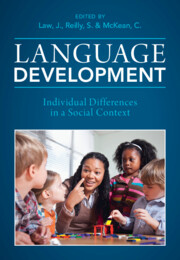Book contents
- Language Development
- Language Development
- Copyright page
- Contents
- Figures
- Tables
- Contributors
- A Tribute to Our Friend, Colleague and Fellow Editor, Professor James Law
- Introduction
- Part One Factors Influencing Language Development
- Part Two Continuity and Change
- 11 Language Trajectories in Childhood
- 12 Patterns of Language Development from Childhood to Adulthood and the Associated Long-term Psychosocial Outcomes
- 13 Social Inequalities in Vocabulary and the Role of Reading
- 14 The Dynamic Nature of Predictors and Outcomes in Children’s Language Development over Childhood
- Part Three Impact, Intervention and Equity
- Index
- References
12 - Patterns of Language Development from Childhood to Adulthood and the Associated Long-term Psychosocial Outcomes
from Part Two - Continuity and Change
Published online by Cambridge University Press: 11 August 2022
- Language Development
- Language Development
- Copyright page
- Contents
- Figures
- Tables
- Contributors
- A Tribute to Our Friend, Colleague and Fellow Editor, Professor James Law
- Introduction
- Part One Factors Influencing Language Development
- Part Two Continuity and Change
- 11 Language Trajectories in Childhood
- 12 Patterns of Language Development from Childhood to Adulthood and the Associated Long-term Psychosocial Outcomes
- 13 Social Inequalities in Vocabulary and the Role of Reading
- 14 The Dynamic Nature of Predictors and Outcomes in Children’s Language Development over Childhood
- Part Three Impact, Intervention and Equity
- Index
- References
Summary
Language is fundamental to success in many life domains, and children showing vulnerabilities in their language development may be at risk of poorer lifelong outcomes. This chapter synthesises evidence from longitudinal population-based and community samples to describe the long-term psychosocial outcomes associated with a history of language problems. Notably, this chapter centres on the outcomes of late talkers and children with developmental language disorder (DLD). The chapter begins by profiling the outcomes experienced when language difficulties are identified at a single point in the child’s development. Next, the influence of changes in language profiles over time on the long-term psychosocial outcomes is considered. Throughout the chapter, outcomes are explored across key areas including literacy and numeracy, educational and vocational attainment, emotional and behavioural functioning, social connections, and mental health and well-being. The studies presented show that while heterogeneity exists, children with language problems at one point in development are at increased risk of difficulties in other domains of life, and these adverse outcomes can persist into adulthood.
- Type
- Chapter
- Information
- Language DevelopmentIndividual Differences in a Social Context, pp. 281 - 301Publisher: Cambridge University PressPrint publication year: 2022



